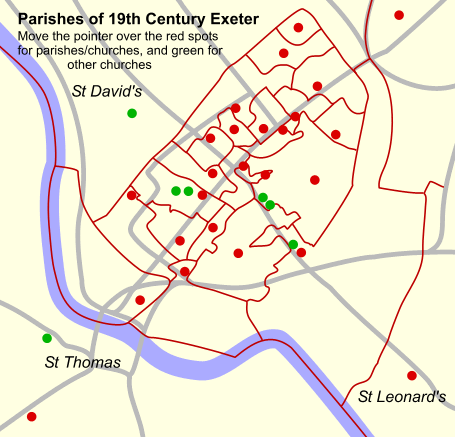
The Churches and Parishes of Exeter
Back to Histories of individual Churches

Move the pointer
over the red spots
It is not known when Christianity reached Exeter, but it was around about 450 AD that it became known as Moncton. It was in 680 that a young boy named Winfrid from Kirton (Crediton) gained his father's permission and went to the abbey St Mary and St Peter of Adescancastre or Exeter. This lad became St Boniface who converted the 'lands to the east of the Rhine' to Christianity.
As the fledgling Exeter grew, churches were built - in fact, for its size, rather a lot of churches. By the coming of the Normans there were about 32 churches within or close to the city wall including Allhallow's Goldsmith Street, St Lawrence, St Pancras, St Stevens, St Martins, St John's and St Olave's.
The other great church was of course the cathedral - the abbey, was burnt to the ground by the Dane Sweyne in 1003. Bishop Leofric obtained permission in 1050 to move his see to Exeter from Crediton. The Normans felt that a grander building would be required so a new Cathedral was constructed, with two towers from the first phase, and the West Front from the second. It was from this building spree that St Mary Steps, was built. The Saxon churches were also rebuilt during the period. In 1222 parish boundaries were devised, following ancient street lines and features such as the wall. Churches were lost - St Cuthbert and St James near Trinity.
The Reformation removed the two monasteries - St Nicholas's and Polsloe Priory. Two friaries, the Dominican Friary in what would become Bedford House and the Franciscan Friary outside the South Gate at Friernhay close to Colleton Crescent also went. Priories such as St James, Cowick had been dissolved years before.
The turmoil created by Henry VIII lasted to beyond the Civil War with the people never sure whether to be Popish or Lutheran. Protestantism took control, but a new bunch of religious troublemakers appeared - dissenters. George Fox a Quaker preached at the Seven Stars Inn in 1657, and John Wesley preached at St Mary Arches in 1739.
New Churches and chapels for these beliefs appeared - George's Meeting Hall of 1760, and the Wesleyan Mint of 1813. The turn of the 20th Century saw the United Reformed Church Heavitree and the Sidwell Street Methodist Church completed. Between 1850 and the present many old churches have disappeared - St George's, St Paul's, Allhallow's and St Mary Major demolished, St James and St Lawrence destroyed by bombing.
And now - what remains of Exeter's church heritage. George's Meeting House is a pub, Trinity the White Ensign Club, and St Petroc's a homeless centre. Most of the rest are still used for worship.
│ Top of Page │